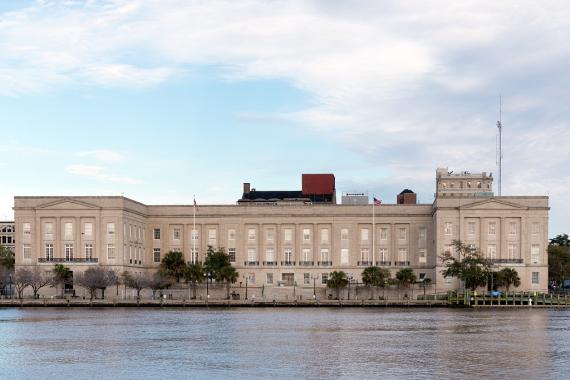Location: 2 Princess St, Wilmington, NC 28401
At the turn of the nineteenth century, Wilmington was the largest city in North Carolina and a leading port and shipping center for tar and turpentine. In 1819, the government purchased property facing the Cape Fear River for a custom house to collect duties for ships entering or leaving the port. In 1840, that building burned and a second custom house, post office, and courthouse was constructed on the site. Designed by John Norris, the dignified yet small Greek Revival style building opened in 1845. It served the city until the early twentieth century, when it was determined inadequate and a new building was planned.
Between 1908 and 1910, Congress appropriated funds for both the acquisition of adjacent properties and construction. In 1915, the old custom house and surrounding buildings were demolished. The new federal building was designed by the Office of the Supervising Architect, first led by Oscar Wenderoth, and completed under his successor James A. Wetmore. Its inspiration came directly from Norris’s design, and the end pavilions recreated the temple facade of the 1845 building. In December 1916, the cornerstone was laid, but material shortages during World War I and a Spanish Influenza outbreak delayed construction. The building opened in 1919 at a cost of $500,000. Its courtyard design by landscape architect Julia Lester Dillon drew praise from the local newspaper, which noted, “The patio, as a whole, will have a beauty and charm seldom found in connection with a public building.”
The building was listed in the National Register of Historic Places in 1974. In 1976 it was renamed to honor Wilmington native Alton Asa Lennon (1906–1986) who served in the U.S. Senate from 1953 to 1954, and then was the representative for North Carolina’s 7th congressional district from 1957 to 1972. In the 1980s, Riverfront Park, which includes part of the city’s Riverwalk, was constructed in the location previously known as Government Park or Custom House Pier. Today, the west facade overlooks this park.
Facts
- Architect: James A. Wetmore
- Construction Dates: 1916-1919
- GSA Building Number: NC0085ZZ
- National Register of Historic Places Landmark Status: National Register Listed

 U.S. General Services Administration
U.S. General Services Administration
